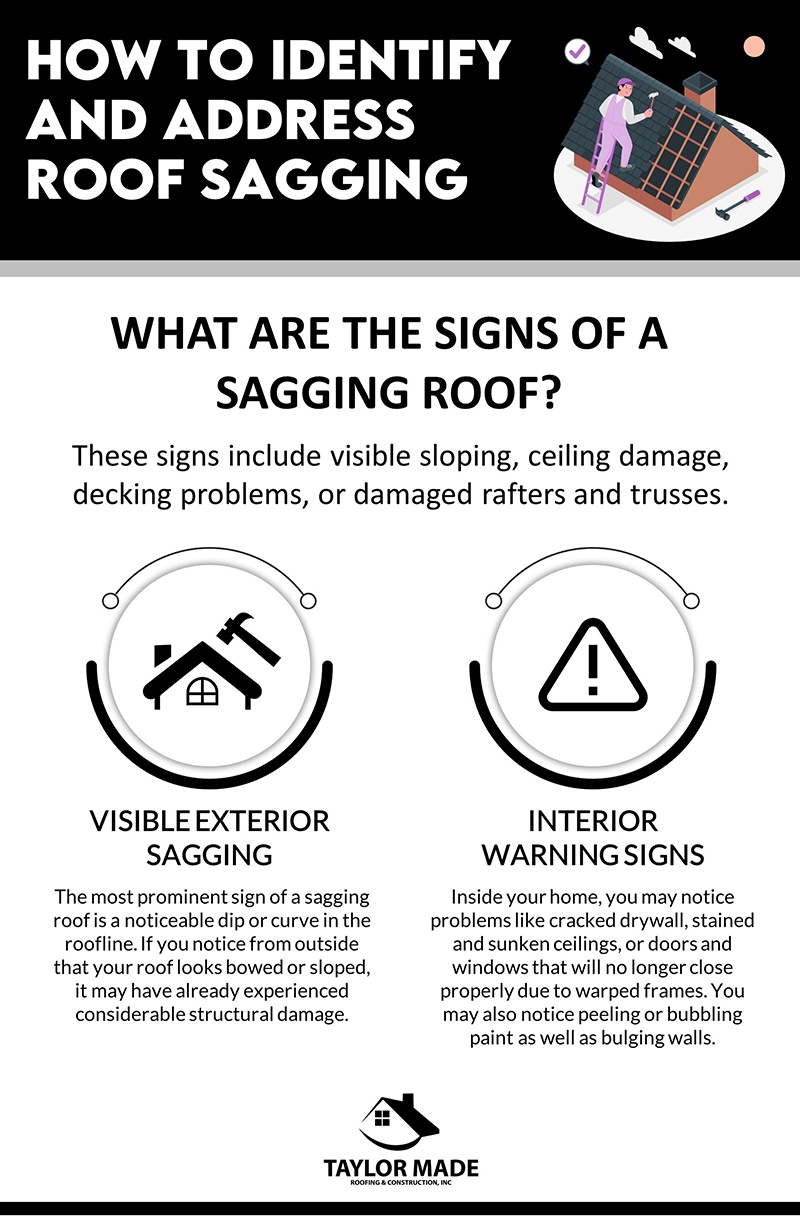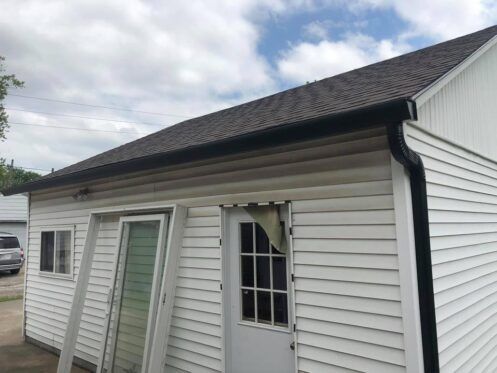One of the most devastating problems that can occur with this structure is a sagging roof. Not only does this occurrence make your roof less effective in protecting your home from harsh weather and temperatures, but excessive sagging can eventually result in complete collapse. Fortunately, there are steps you can take to rectify the problem before it escalates into irreversible damage. This guide will walk you through recognizing and addressing roof sagging and help you take the first steps in protecting your household.
What Are the Signs of a Sagging Roof?
A sagging roof signifies a severe structural issue that requires professional intervention. However, there are often symptoms or indicators that can help homeowners recognize when it is time to seek expert help. These signs include visible sloping, ceiling damage, decking problems, or damaged rafters and trusses.
Visible Exterior Sagging
The most prominent sign of a sagging roof is a noticeable dip or curve in the roofline. If you notice from outside that your roof looks bowed or sloped, it may have already experienced considerable structural damage. The depression or distortion often occurs toward the center of the roof as the structure struggles to uphold surrounding materials and weight. In very old roofs, sagging can appear in several spots and give the ridgeline a wavy appearance.
Interior Warning Signs
There are interior warning signs that can indicate roof sagging as well. Inside your home, you may notice problems like cracked drywall, stained and sunken ceilings, or doors and windows that will no longer close properly due to warped frames. You may also notice peeling or bubbling paint as well as bulging walls. These signs indicate an increase in stress or pressure that the roof has put on the remaining home structure.
Roof Decking Problems
Major roof issues can also cause problems with your roof decking. This type of bending is normally visible near the attic or crawl space. If your decking starts to look warped, reach out to a professional to officially diagnose the issue.
Drooping Rafters or Trusses
In the most severe cases, you may also notice drooping along the rafters or trusses that support the roof. This is a critical sign that demands immediate attention to prevent structural collapse.
What Are the Possible Causes of a Sagging Roof?
Understanding the possible causes of a saggy roof can help you identify troublesome factors early and address them during your next professional checkup or maintenance session. Common causes of sagging include moisture damage, structural overload, faulty installation, or structural aging.
Water Damage
Water damage is one of the top causes of a saggy roof. This often occurs due to the accumulation of rainwater. If your roof or gutter systems are somehow unable to divert rainwater from the rooftop, for example, the result is water buildup. The moisture can cause serious roof leaks and wood rot or even encourage the growth of algae and mildew over time. This excess water can also pool into soft spots or depressions on the roof and eventually create sagging. Moisture-related wood rot can also weaken materials like support beans and create a secondary source of sagging.
Structural Overload
Similar to water damage, any type of excessive load can cause your roof to sag. Precipitation like snow, ice, hail, or sleet can accumulate on your roof, and the excess weight can weaken the underlying structure and cause drooping. Harsh winds can also blow in leaves, branches, and other debris that settles in large quantities on your roof. Eventually, the poor distribution of foreign objects can accumulate in weak spots and damage the roof. Even the extra weight from improperly sized HVAC units, solar panels, or shingles can put an undue load on your roof and cause it to distort.

Improper Installation
Faulty installation can cause your roof to sag prematurely. For example, the National Roofing Contractors Association (NRCA) reports that professional roofers use an average of 34 industrial-grade tools to install roofs. Amateurs who attempt to install roofs themselves may find that they lack the equipment to complete the job correctly. For this reason, you should always work with a professional roofing company to ensure quality.
Poor Ventilation
Extremely poor ventilation in the attic can lead to a sagging roof. Inadequate airflow can lead to excessive heat and moisture buildup in the attic. For example, according to the Department of Energy, an unventilated attic can reach 150 degrees Fahrenheit during the summer. This concentration of heat and humidity can weaken your roofing structure.
Termite Damage
Termites include several species of pests that feed on domestic wood. If left unaddressed, the termite infestation can become severe and result in a sagging roof. This is particularly common among older homes in which parts of the wood may have already begun to decay.
Old Age
Some roofs begin to sag naturally over time. Factors that influence the aging process include the frequency of maintenance as well as the type of roofing material used. But if your roof is over 25 years old, ask your roofer to check whether the roof has begun to show signs of deterioration and if the home is a candidate for a roof replacement.
What Are the Steps to Address a Sagging Roof?
While a sagging roof may seem alarming, there are steps you can take to address the issue. Because sagging can result from a host of sources and can include complications or underlying issues, you should never try to fix sagging on your own. The ways to address a sagging roof include consulting a professional for inspection, troubleshooting, and repair or replacement. Following the initial inspection, you can also follow up with consistent routine maintenance.
Consult a Professional
A professional can evaluate the severity of the issue and devise a plan to correct the issue. For example, minor sagging may require temporary support beams while the roofer uses specialized equipment to fix the affected area. A roofer may also need to fix small cracks or leaks to prevent moisture from further damaging your building. However, moderate sagging may require the roofer to reinforce or replace your deteriorated rafter and trusses. The roofing professional may also need to locate and replace shingles or sheathing. This helps reinforce the integrity of your roof and prevents further sagging. Unfortunately, the most severe sagging may require re-roofing. If your structure is on the verge of collapse or damaged beyond repair, a qualified roofer can offer a replacement solution that ensures a sturdy roof for years to come.
Schedule Regular Maintenance Sessions
After your initial inspection and repair or roofing replacement, you should also sign up for regular maintenance sessions. During maintenance, a roofer may check for leaks and perform duties like clearing the roof of ice dams or unclogging gutters to ensure water flow. Some roofers also check attics to confirm sufficient ventilation. You can schedule emergency maintenance sessions following severe weather events. Maintenance is key to prevention and can help extend the lifespan of your roof.
Get Help From the Experts Today
A saggy roof is a major eyesore and can compromise the safety and value of your property. Fortunately, the experts can help. Taylor Made Roofing & Construction, Inc. provides roofing services for homes in Shingle Springs, CA and surrounding areas. We offer roof installation, inspection, and repairs. In addition to roofs, our contractors offer matching installation of siding, decking, windows, and doors. If you are experiencing problems with wood, we can repair dry rot and offer other appropriate solutions. Contact Taylor Made Roofing & Construction, Inc. for all your roof construction needs.




